Lemon Alfredo Sauce is quick to make and always a crowd-pleaser, whether twirled on a fork with pasta or ladled over roasted vegetables.
This lemony cream sauce is layered with the flavors of parmesan and romano cheese, white wine, garlic, shallot, heavy cream, and a squeeze of lemon. Grab some crusty bread, and let’s get to it!
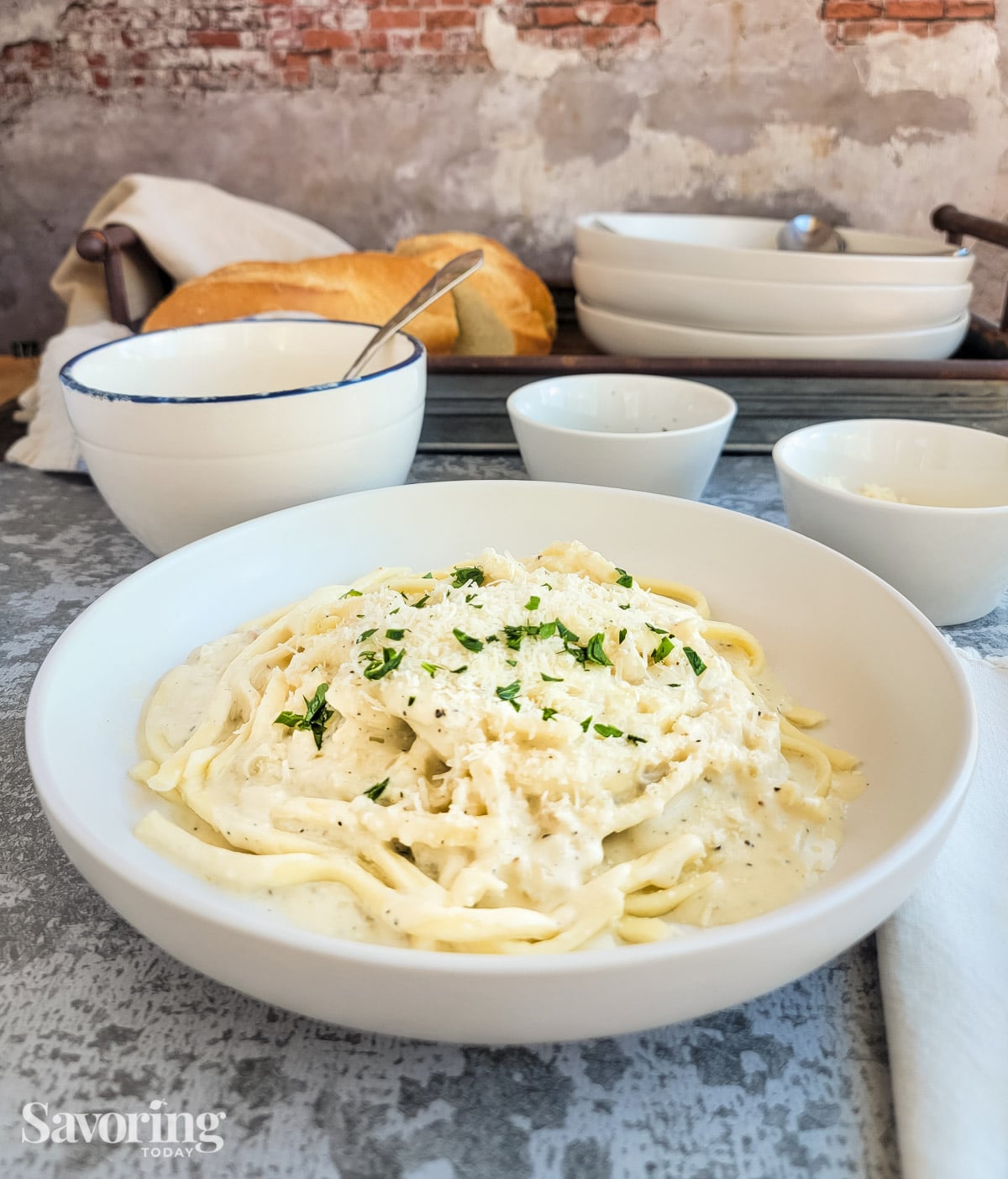
When it comes to classic comforting pasta dishes, Alfredo sauce tops the list. Its creamy, indulgent texture has made it a staple in kitchens everywhere.
Butter, parmesan cheese, salt, and pepper are all you need to make a traditional Alfredo sauce, but we’re not making the traditional sauce here. Why? Because we love the added flavor of garlic with the acidic balance of lemon and wine to brighten and lift the creaminess of the butter and cheese.
What happens when you add the twist of lemon to this beloved sauce? The result is a lightly zesty and refreshing flavor profile that makes the last bite as tasty as the first. This vibrant sauce complements a wide range of dishes like lasagna or veggie pizza, and its citrusy notes enhance the natural sweetness of seafood or grilled chicken.
Whether you’re planning a romantic dinner for two or a family gathering, lemon Alfredo is sure to impress with its bright, satisfying flavors.
Fun Fact: Alfredo (AL-fray-doh) a common Italian and Spanish name, means “Elf Counselor” in Italian.
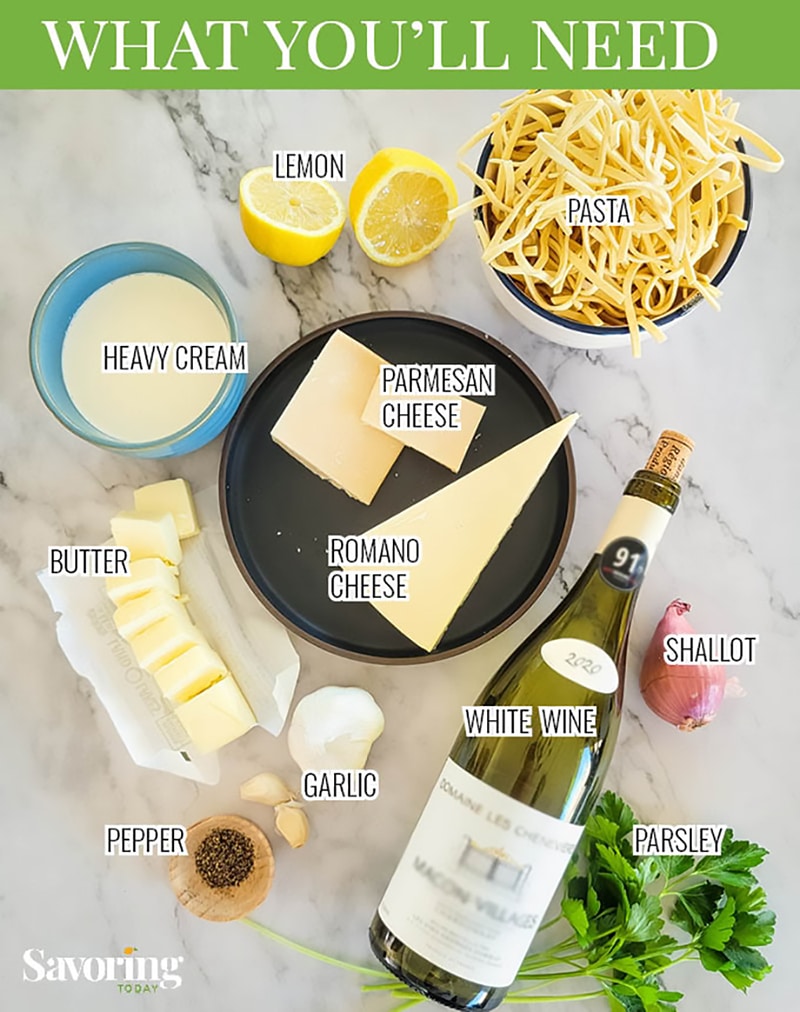
RECIPE PRO TIPS: fresh cheese, timing, and temperature
- Use freshly grated parmesan and Romano cheese. Pre-grated cheeses can cause the sauce to taste grainy due to anti-caking agents like cellulose.
- Finely grated cheese melts easily and creates a smoother texture—chunks of parmesan or romano won’t melt down. This is our favorite parmesan cheese grater.
- Stir in the cheese off-heat so it will melt and not separate. You’ll notice in the recipe we add the parmesan and romano towards the end, over low heat or off heat.
- Add the lemon juice last so the flavor shines and it doesn’t curdle the sauce.
Best White Wine for Alfredo Sauce
Pinot grigio or chardonnay are ideal for making alfredo sauce or pairing it with alfredo. The best choice will depend on your personal preference. If you like a drier, full-bodied wine, go with a chardonnay; if you prefer a light, crisp, and floral taste, go with Pinot Grigio.
My preference is Pinot Grigio, but I’ve used both successfully.
The most important thing is to use a wine you would drink and never use “cooking wine” you find in grocery stores (usually shelved by the vinegars), which is poor wine with added sweeteners or salt.
Best wine substitute = stock + lemon juice
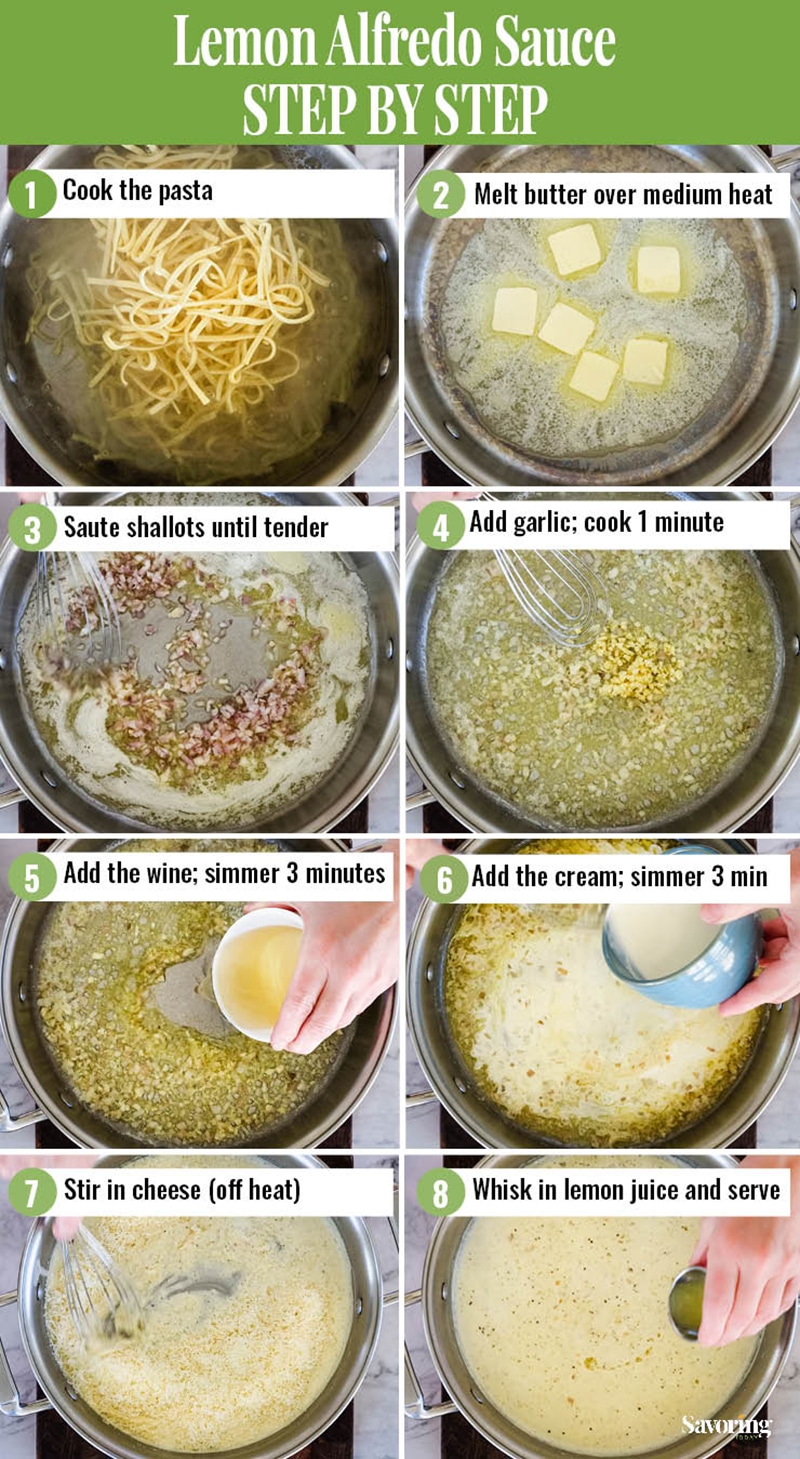
Recipe STEP BY STEP
- Cook pasta AND Reserve 1/2 cup of the pasta cooking liquid and then drain.
- Melt the butter in a medium saucepan over medium heat.
- Add shallots and cook until tender, 3-4 minutes.
- Reduce heat to medium-low, add garlic, and cook for 1-2 minutes, until fragrant.
- Add the wine and simmer until reduced by half, about 3 minutes. (The best way to gauge the reduction is to tip the pan to check the liquid level at the bottom edge.)
- Whisk in heavy cream and simmer for 3-4 minutes until the sauce reduces and thickens slightly. (At this point, it should coat the back of a spoon.)
- Remove from the heat and stir in half the Parmesan and all the Romano cheese.
- Stir in the lemon juice and serve with a garnish of cheese and fresh parsley.
Recipe Variations
- For more lemon flavor, add lemon zest along with the juice
- Substitute stock and lemon juice for the wine
- Substitute brown rice pasta or zucchini noodles for regular pasta
- Substitute green onions for shallots; use only the white to light green part of the green onions
- Substitute chicken stock for the white wine
- Garnish with scallions (green part of the onion) instead of parsley
- Make it with less dairy—check out our Cauliflower Alfredo Recipe
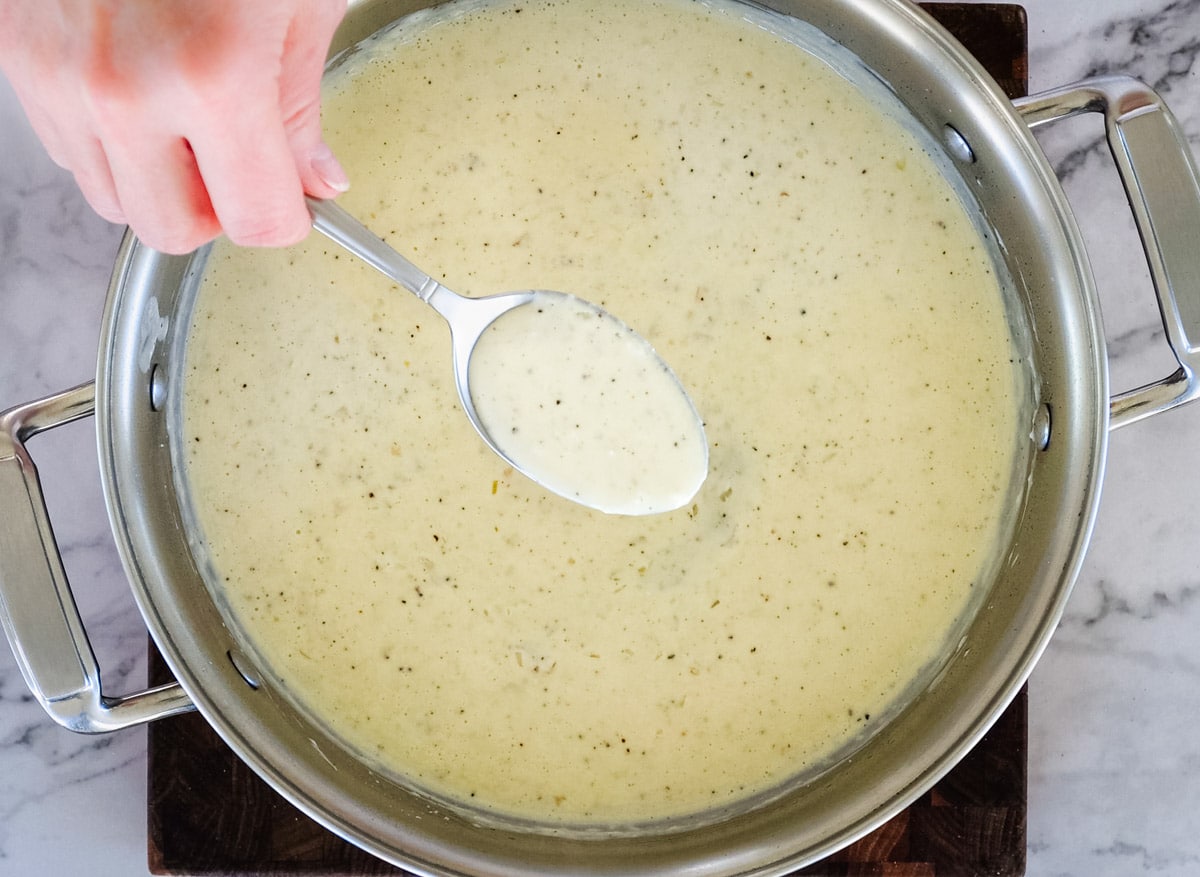
Thicker or thinner sauce?
Ideally, the sauce will coat the back of a spoon. While this might seem a little thin, it will thicken as it cools and when added to starchy pasta. You want a velvety sauce to latch onto tasty pasta noodles or vegetables.
This recipe shouldn’t need extra steps to thicken or thin the sauce, but if it does, here are some suggestions:
To thin the sauce: Stir in a little pasta water or milk.
To thicken the sauce: Simmer in the pan for a few more minutes before adding the lemon juice. (And keep in mind that the sauce will thicken as it rests off heat.)
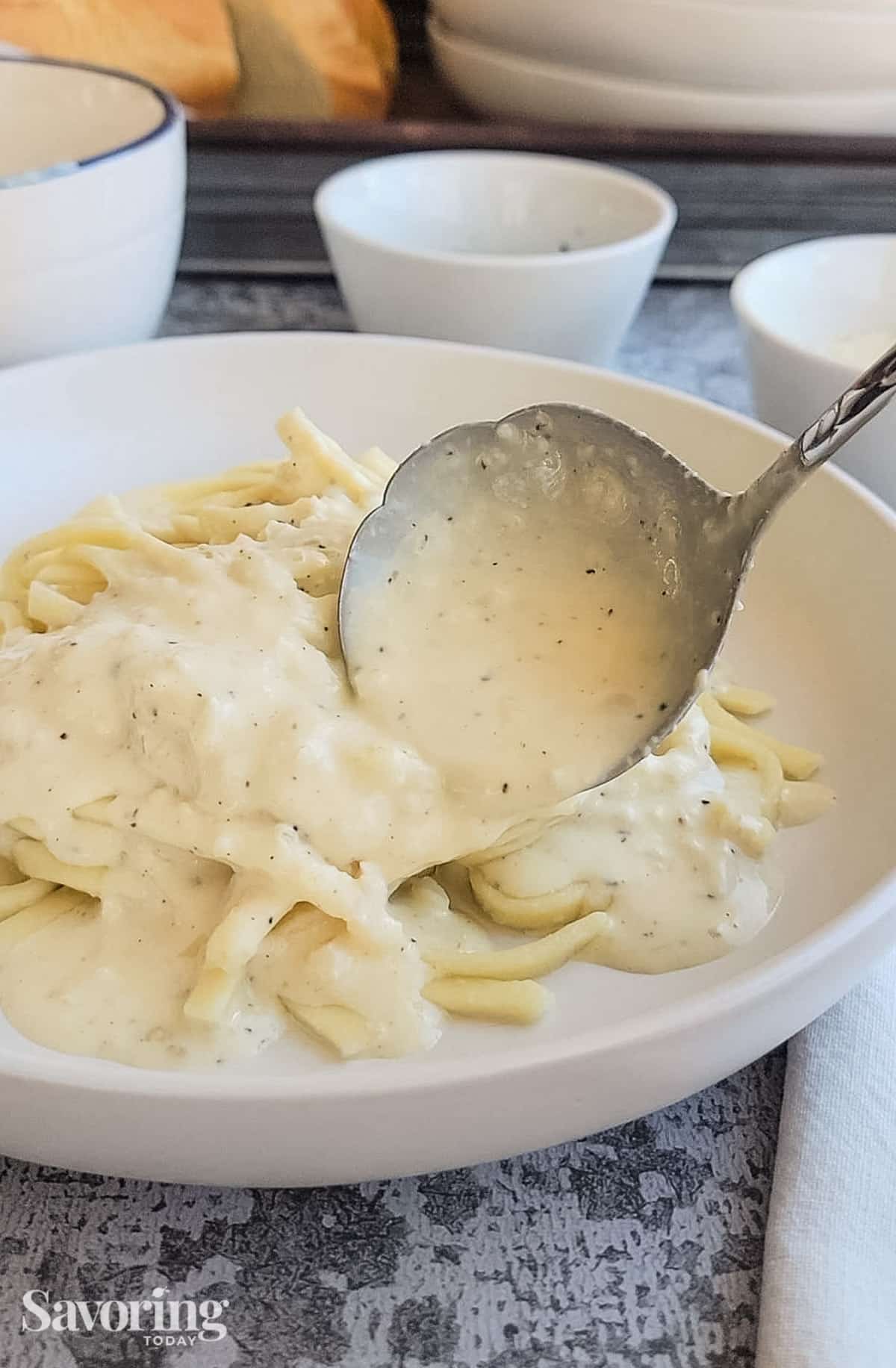
Can I freeze Alfredo sauce?
Yes, you can freeze Alfredo sauce! To freeze the sauce, cool it completely and divide it into meal-size portions—we figure ¼ cup per serving. Freeze in a freezer zip-type bag and press flat, or in these handy cube containers.
Note: if freezing in cube containers, once frozen, pop out into a freezer bag or vacuum seal to save space for long-term storage. Freeze for up to 1 month, or up to 6 months if vacuum sealed.
The BEST way to reheat Alfredo
The best way to reheat alfredo sauce is slowly over low heat. Sauces that contain milk fats and oils will separate if heated too quickly (think microwave) so it is best to gently warm it over low heat in a saucepan while stirring frequently.
Cold Alfredo is quite thick but will loosen when heated. If it is still too thick once it melts, stir in a little milk, chicken stock, or pasta water to thin the sauce.
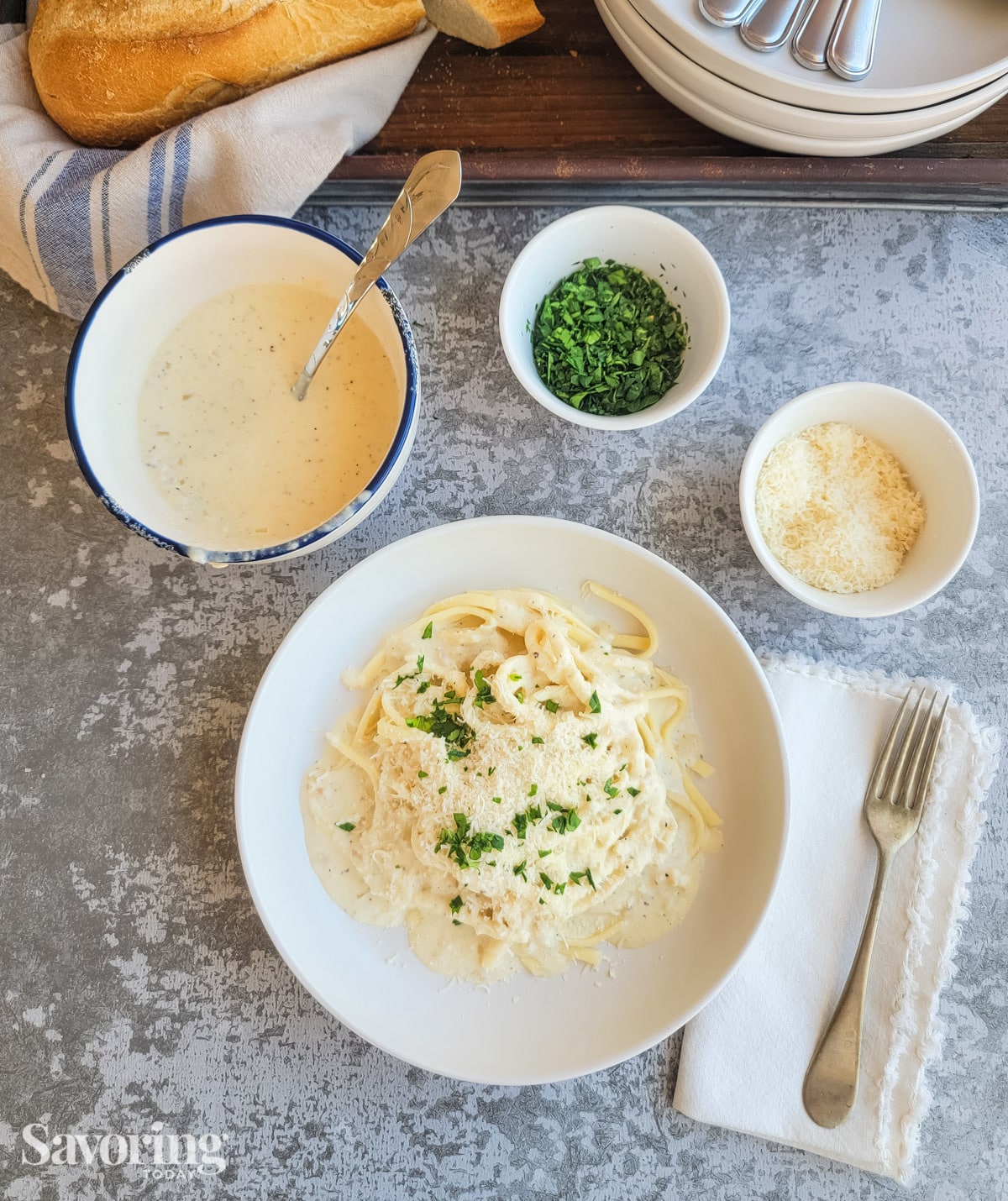
More Ways to Serve Lemon Alfredo
- Stir shrimp or crab meat into the sauce
- Top with blackened salmon, grilled chicken, or roasted vegetables
- Pour over broccoli and cauliflower or layer in a lasagna or pasta bake
- Use as a pizza sauce base with grilled chicken, mushrooms, and caramelized onion
- Garnish with fresh basil and diced fresh tomatoes on top of the finished Alfredo
- A dip for flatbread
What if I already have a jar of Alfredo? Can I make it taste better?
Store-bought Alfredo sauce can include sugar, soybean oil, enzyme-modified cheese paste, or preservatives—it’s why it is gravy-thick and often tastes over-seasoned.
- Thin it—add pasta water, milk, or broth to thin the sauce so it thinly coats the pasta.
- Balance the seasoning—adding a small amount of lemon juice or wine brightens the flavor and helps tone down salty or flat-tasting sauces.
- Add freshness—chopped parsley, basil, chives, and thyme make a big difference in making store-bought foods taste more homemade.
- Bring the heat—adding a dash of hot sauce or crushed red pepper won’t make it spicy but will elevate the flavors already present.
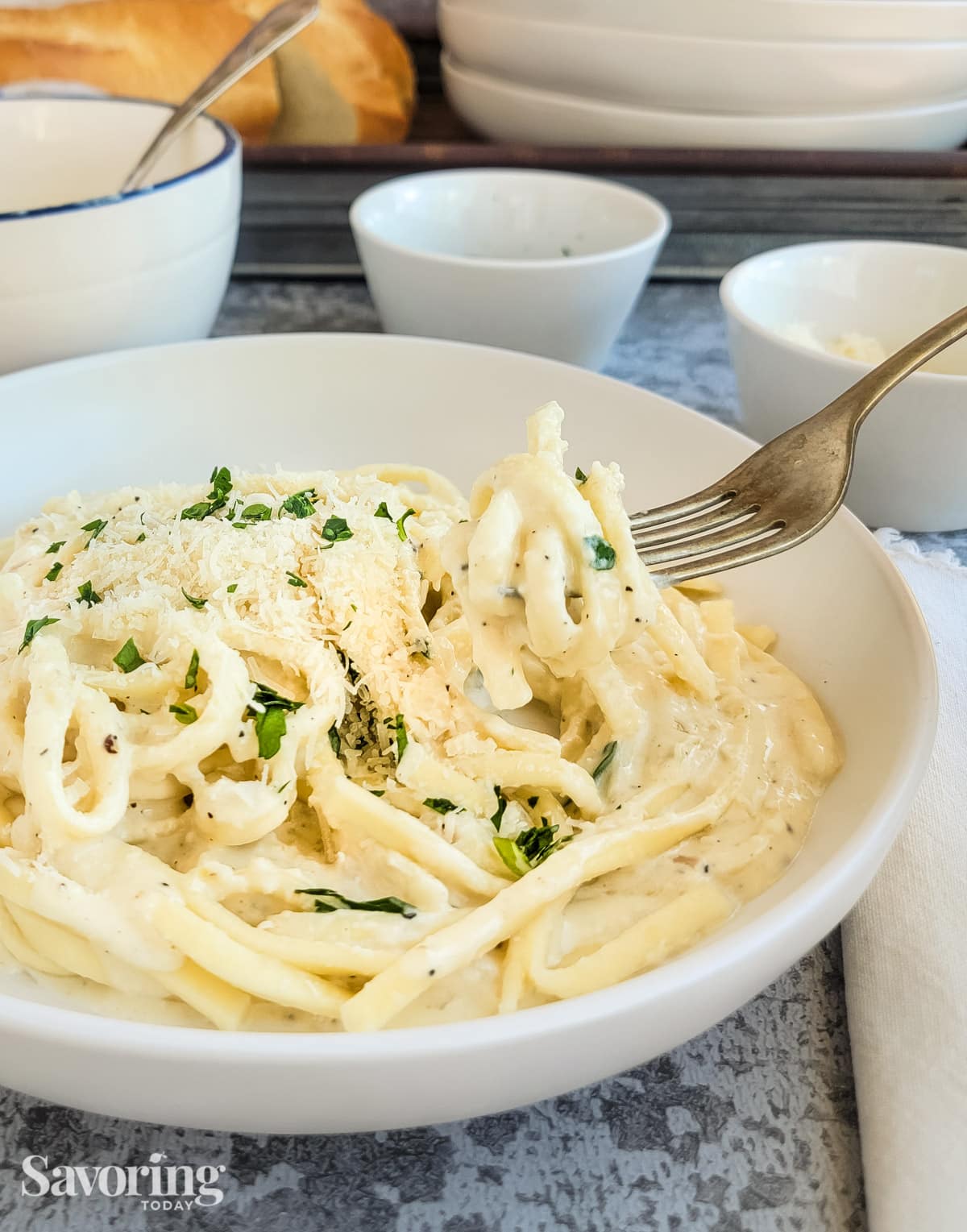
More Sauce Recipes You’ll Love
- Roasted Cherry Tomato Sauce
- The Very Best Marinara Sauce
- Homemade Chili Sauce
- Spaghetti Bolognese
- Chimichurri: The sauce every griller needs
- Mushroom & Blue Cheese Ragout
Lemon Alfredo Sauce with White Wine & Garlic
Ingredients
- 1 pound pasta , gluten-free pasta
- 6 tablespoons butter
- 2 tablespoons minced shallot
- 2 cloves garlic , minced
- 1/2 cup Romano cheese , shredded
- 1 cup Parmigiano-Reggiano , shredded, divided
- 1/2 cup dry white wine Pinot Grigio or Chardonnay
- 1 cup heavy cream
- 1/2 teaspoon freshly ground black pepper
- 1 tablespoon freshly squeezed lemon juice
- 1/4 cup finely chopped parsley for garnish (optional)
Instructions
- Cook pasta in a pot of rapidly boiling salted water until al dente or according to package directions. Reserve 1/2 cup of the pasta cooking liquid and then drain. While the pasta is cooking, begin the sauce.1 pound pasta
FOR THE SAUCE
- Melt the butter in a medium saucepan over medium heat. Add shallots and cook until tender, 3-4 minutes. Reduce heat to medium-low, add garlic, and cook for 1-2 minutes, until fragrant. Add the wine and simmer until reduced by half, about 3 minutes. (The best way to gauge the reduction is to tip the pan to check the level of liquid at the bottom edge.)6 tablespoons butter, 2 tablespoons minced shallot, 2 cloves garlic, 1/2 cup dry white wine
- Whisk in heavy cream and simmer for 3-4 minutes until the sauce reduces and thickens slightly. (At this point, it should coat the back of a spoon.)1 cup heavy cream
- Remove from the heat and stir in half the Parmesan and all the Romano cheese, then stir in the lemon juice. The sauce will thicken as it cools.1/2 cup Romano cheese, 1 cup Parmigiano-Reggiano, 1/2 teaspoon freshly ground black pepper, 1 tablespoon freshly squeezed lemon juice, 1/4 cup finely chopped parsley
- To serve with the pasta already dressed: Return the pasta to the pot it was cooked in, set over medium-low heat along with 1/4 cup of the reserved cooking liquid (reserve the other 1/4 cup to thin sauce, if needed), toss with the sauce, and serve. To serve the pasta (or zucchini noodles) and sauce separately: Serve noodles on each plate and spoon sauce over noodles.
- Garnish with the remaining Parmesan and parsley. Serve immediately.
Video Displays Here or In Post
Notes
- For more lemon flavor, add lemon zest along with the juice
- Substitute brown rice pasta or zucchini noodles for regular pasta
- Substitute green onions for shallots; use only the white to light green part of the green onions
- Garnish with scallions (green part of the onion) instead of parsley
- Substitute chicken stock for the white wine
- Make it with less dairy—check out our Cauliflower Alfredo Recipe
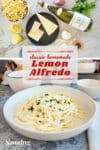

Teri says
Oh my, this alfredo is as good as any I’ve had in a restaurant!
April @ The 21st Century Housewife says
I love Alfredo Sauce, and your version sounds just wonderful. I like the addition of the lemon juice. Thank you for sharing this post with the Hearth and Soul Blog Hop.
Kirstin says
YUM!! I love alfredo. This looks yummy and I love your recipe. I make a 4 cheese fettucini sauce that is super good..
Judy says
More cheese, I’m in! 😀
Judy says
Raquel, I applaud your efforts to understand what you are eating and monitor/control ingredients, we are diligent about this same thing. Alfredo has received a bad rap because of its fat content, though it is all good fats. Yes, good fats. Obviously, portion control is key with any meal and a generous serving of vegetables with this recipe is important. With proper meal rotation (variety), quality ingredients (no low-fat or artificial stuff), and portion control, there is no reason to avoid a real cream sauce now and again. Good for you for paying attention to nutrition.
rsmacaalay says
I love alfredo sauce and in fact any creamy pasta sauce would do. Will be making one soon but the seafood version: )
Judy says
My favorite is with blackened salmon.
thepintsizechef says
This look so delicious! 🙂